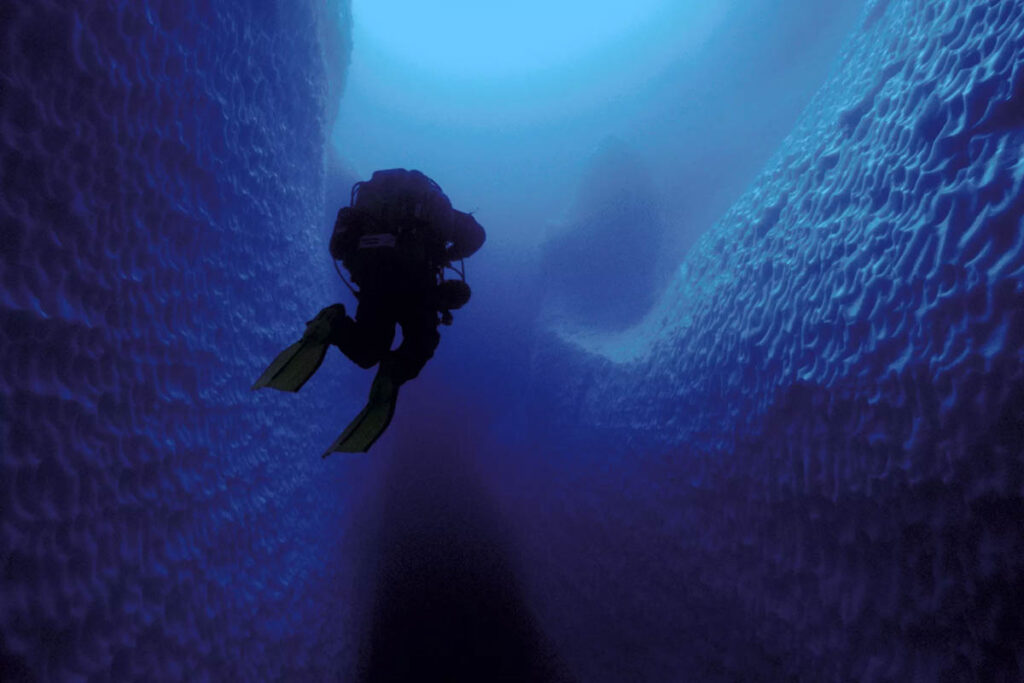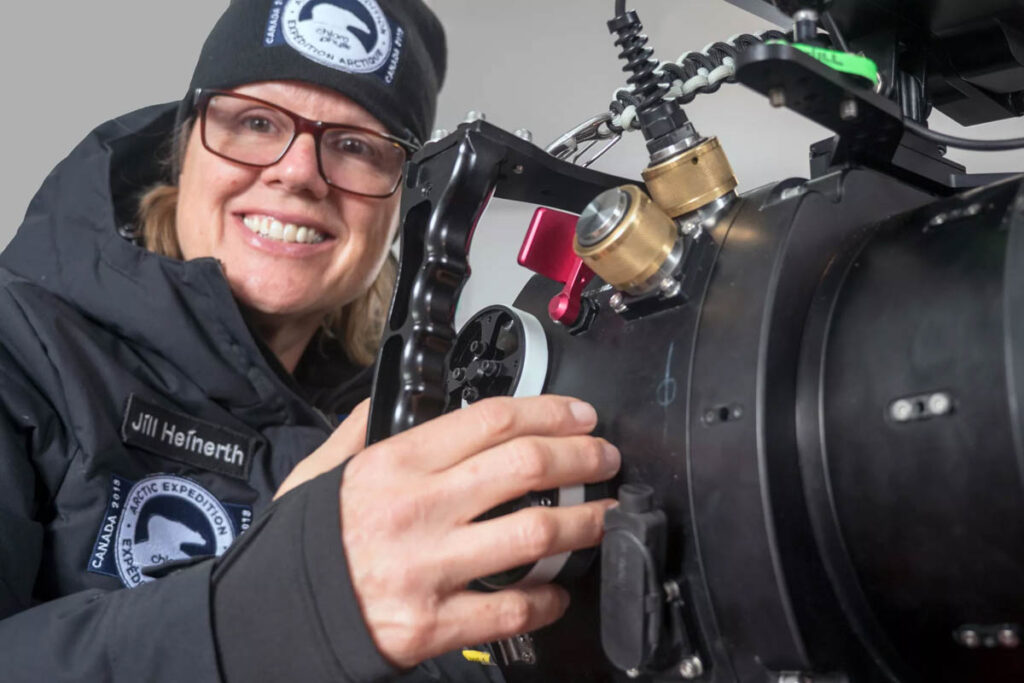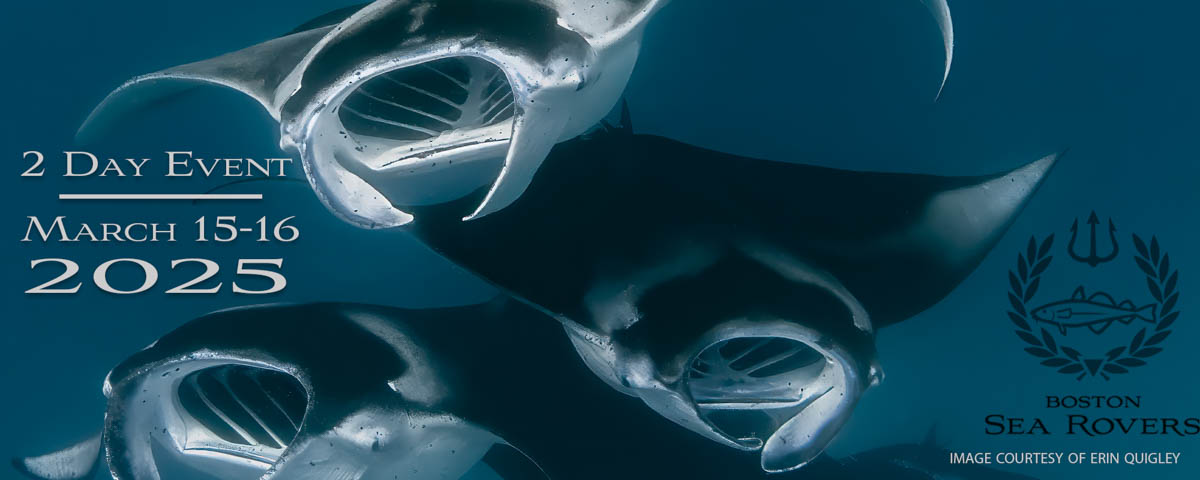“When they say your life flashes before your eyes, it doesn’t really. You think a couple of really stupid thoughts. And then you go, ‘Wait a minute. I’ve got to focus ” says Jill Heinerth
Jill Heinerth, the Explorer in Residence at Royal Canadian Geographical Society, wasn’t sure there were caves inside an iceberg because no one had ever been inside one before, but she was willing to strap on her underwater gear and find out for herself. It nearly cost her and her crew their lives
During the dives, Heinerth, now 60, her former husband Paul Heinerth and late camera operator Wes Skiles, encountered unpredictable currents, freezing temperatures and other life-threatening challenges as they navigated the often treacherous territory under the ever shifting ice
On their last dive of the day, the group narrowly escaped being trapped when they were sucked into the iceberg by a current strong enough to propel the iceberg across the Ross Sea. Here is her story, told to PEOPLE’s Susan Young, in her own words:
I know it all seems so crazy in retrospect. Everything seems to make sense until you come home and tell people.
The intention was to go down and intercept the largest iceberg in recorded history. I thought taking these risks really mattered for our understanding of the planet and the changes that we were facing moving forward, but I was nervous.
You can’t count on anything remaining stable in Antarctica, because when that sea ice blows in chunks and pieces, it forms up really quickly. Just finding your way out of the water in between chunks of ice is pretty scary.
The iceberg we were diving inside of was made of fresh water, and we were obviously diving in the ocean, which is salt water. So you have two different densities of water. As that iceberg is melting, it’s creating these weird currents and turnovers because of the two densities. So at times, we would be swimming close to the ice and then suddenly be sucked downward. It really felt like a chaotic environment. It was adapt or die.
I was peering down this crevasse made of ice that seemed to descend through every color of blue you could imagine until it was just twilight black. And the walls on either side of me looked like golf balls, all these divots carved by the wave action and melting. It was loud, too. You could hear cracks and pops and fizzes as the ice melted.

You could also see the ice sort of letting out big gas bubbles. As we descended, there were layers that were quite white and snowy, while other layers were transparent like glass. And yet it wasn’t void of life. There were fish living in the ice and thousands of mating pairs of these giant crustaceans dropping out of crevices on top of us, like giant crabby spiders.
We dropped down to about 130 feet deep, not knowing even where the seafloor was. And that’s really at the edge of where we wanted to be working in this very cold environment because deep dives require a longer time to slowly come back to the surface.
Above me was this blue, gorgeous sculpted white ice and archway that reached out beyond my ability to see. Meanwhile, on the seafloor were all these yellow and red and warm colored filter feeding organisms creating this sort of shag carpet of life.
And I should have paid attention immediately because the current was strong, and the current brings food to the stationary animals that were anchored tightly into the sea floor. And that should have been one of those sort of ‘A-ha.’ Everything was anchored here because it needed to be.
Then the current picked up. We were hearing all of these cracks and thuds. I could feel them in my sternum. We turned to come out and started to swim up, but I realized that that doorway we’d gone into was not there anymore. That ice had either blown in or calved off of the iceberg and literally closed off our access. We needed to find a new way out, and that was pretty unsettling.
Then, we made a second dive in the same location. This time, the current was even stronger and we literally got ripped through the iceberg and deposited on the other side where we had to take a very slow return back to the surface to account for the time that we’d been underwater.
And then the last time we dove in that particular spot, we realized it was a bad idea to let the current sweep us through. The current got so strong I was literally digging my hands into the seafloor to pull myself along.
Plus, now I had this leak in my glove that was sort of paralyzing my hand because it was so cold. I couldn’t feel it anymore. And this one hour dive turned into this three hour fight for our lives.
When they say your life flashes before your eyes, it doesn’t really. You think a couple of really stupid thoughts. And then you go, “Wait a minute. I’ve got to focus.” I’m not able to think about how to get out of the iceberg. I’m just thinking, “What’s the next best step towards survival?” And if you don’t just break it down, then the situation can be mentally overwhelming.
Still, I was thinking we could die
When we were fighting our way out, I was with two other divers. My colleague, who was pulling a very large camera system, yelled out, “Help me with the camera.” And I yelled, “F— the camera. Equipment is optional. I’m not going to give my life for a camera.”
Every time you’re working really hard on the rebreathers, a diving apparatus, you’re actually pushing the limits of what it’s capable of doing. If it’s incapable of processing the amount of carbon dioxide you’re expelling, then you can pass out. And if I was suddenly having to worry about not just myself, but rescuing my colleague, it’d be game over for both of us.
The fear factor, your breathing, everything is about staying as calm as possible. If you pass out, you drown.
My diving colleague had tons of experience, but not on ice water and not on the rebreathers. Both of those things together created significant additional risk. And so I consider it like these mountain guides that take a tourist up Everest. You have to take their face in your hands and go, I know we’re only a hundred meters from the top, but if we go up there, we’re going to die. We must turn around.
I knew it was time to go
Anyone can call the dive at any time for any reason. And your colleagues aren’t allowed to argue. They just have to obey. Literally minutes later, we might not have prevailed. We might not have gotten out, and there wouldn’t have been any rescue. There was no one there equipped to rescue us. The most qualified people are already in the cave.
When we got back to this crevasse that would lead us back to the surface, I couldn’t go up because every time I tried, the current would sweep us down and back into the iceberg.
We knew we have to stop and let our bodies get reacclimated. We had to find places where we could tuck in and hide against the current. But then you’re still, and it’s colder than ice cubes freezing in your refrigerator because salt water has to be colder to freeze.
Your face is exposed. Your hands are sealed into dry gloves, except that I had one that was leaking. So there’s parts of your body that are literally doused in ice water. So could you put your face in ice water for three hours? I think most people can’t even do the ice bucket challenge.
The worst risk is actually as soon as you hit the surface, when you can literally freeze tissue on the spot, especially if it’s windy when you’re trying to get in the boat. The longer you’re underwater, the more you’re likely to get hypothermia or cold injuries. I was really worried about my hand. It’s (still) very, very painful when my hands warm up and a little bit of a loss of full sensation.
My first words, as I got back to the boat, were, “The cave tried to keep us today.” And it was overwhelming. I knew we had been close to dying, but also I remember having a very acute sense of witnessing a changing world. This is an omen for the planet. I’ve seen the mechanics of how it breaks and that this is happening all over the planet.
It was only hours after that dive that the entire cave that I’d just been inside of, exploded and broke into chunks of slush as far as the eye could see.







